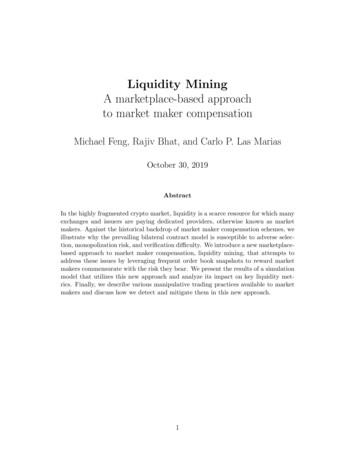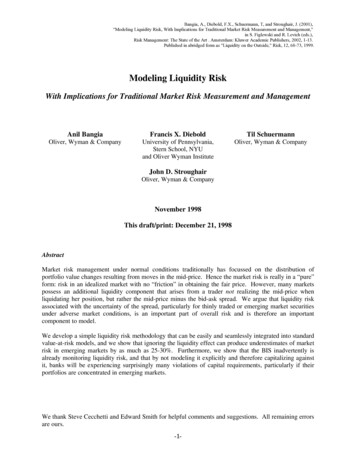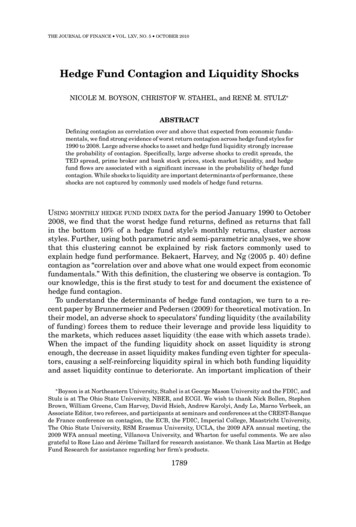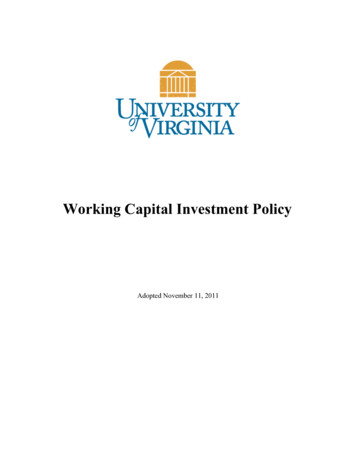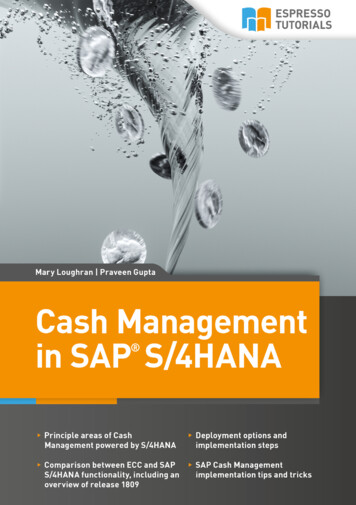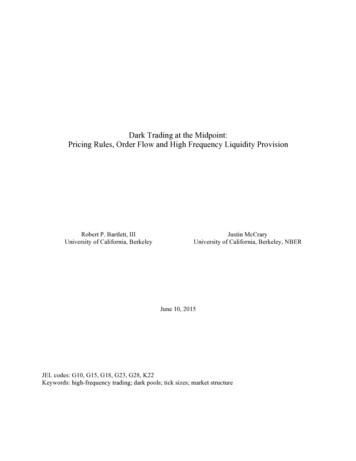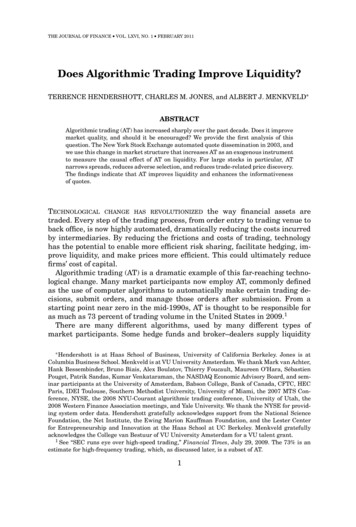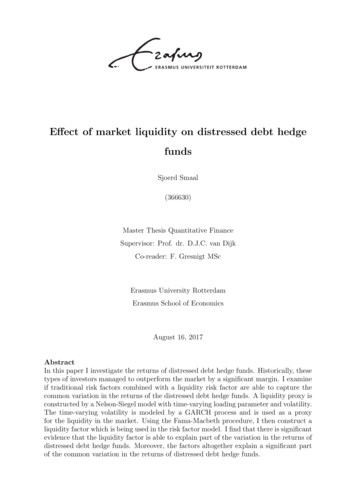
Transcription
Effect of market liquidity on distressed debt hedgefundsSjoerd Smaal(366630)Master Thesis Quantitative FinanceSupervisor: Prof. dr. D.J.C. van DijkCo-reader: F. Gresnigt MScErasmus University RotterdamErasmus School of EconomicsAugust 16, 2017AbstractIn this paper I investigate the returns of distressed debt hedge funds. Historically, thesetypes of investors managed to outperform the market by a significant margin. I examineif traditional risk factors combined with a liquidity risk factor are able to capture thecommon variation in the returns of the distressed debt hedge funds. A liquidity proxy isconstructed by a Nelson-Siegel model with time-varying loading parameter and volatility.The time-varying volatility is modeled by a GARCH process and is used as a proxyfor the liquidity in the market. Using the Fama-Macbeth procedure, I then construct aliquidity factor which is being used in the risk factor model. I find that there is significantevidence that the liquidity factor is able to explain part of the variation in the returns ofdistressed debt hedge funds. Moreover, the factors altogether explain a significant partof the common variation in the returns of distressed debt hedge funds.
CONTENTSMaster’s ThesisContents1 Introduction12 Data52.1Bank of America Merrill Lynch High Yield Bond Index. . . . . . . . . . . . .52.2Risk factors . . . . . . . . . . . . . . . . . . . . . . . . . . . . . . . . . . . . . .92.3Hedge fund returns . . . . . . . . . . . . . . . . . . . . . . . . . . . . . . . . . .103 Extracting a liquidity proxy133.1Nelson-Siegel model . . . . . . . . . . . . . . . . . . . . . . . . . . . . . . . . .133.2Time-varying Nelson-Siegel model . . . . . . . . . . . . . . . . . . . . . . . . .153.3Estimation procedure. . . . . . . . . . . . . . . . . . . . . . . . . . . . . . . .173.4Benchmark proxy: Noise measure . . . . . . . . . . . . . . . . . . . . . . . . . .204 Explaining distressed debt hedge funds returns214.1Fama-Macbeth procedure . . . . . . . . . . . . . . . . . . . . . . . . . . . . . .214.2Risk factors to explain hedge fund returns . . . . . . . . . . . . . . . . . . . . .235 Empirical findings245.1Liquidity proxy . . . . . . . . . . . . . . . . . . . . . . . . . . . . . . . . . . . .245.2Return analysis . . . . . . . . . . . . . . . . . . . . . . . . . . . . . . . . . . . .305.3Robustness . . . . . . . . . . . . . . . . . . . . . . . . . . . . . . . . . . . . . .346 Conclusion37A Sample statistics maturity bins40B Constituents - Credit Suisse Event Driven Distressed Hedge Fund Index41C EM-algorithm for basic DNS, expressions and derivations42D Results factor regressions with Noise measure45i
LIST OF TABLESMaster’s ThesisList of Figures1BoAML HYBI: Selection of maturity bins . . . . . . . . . . . . . . . . . . . . .62BoAML HYBI: 3-D plot . . . . . . . . . . . . . . . . . . . . . . . . . . . . . . .73Average yield curves (1/2000 - 12/2016) . . . . . . . . . . . . . . . . . . . . . .84Principal components . . . . . . . . . . . . . . . . . . . . . . . . . . . . . . . .85Return summary of Credit Suisse, EurekaHedge and S&P500 . . . . . . . . . .116Factor loadings of Nelson-Siegel model (λ 0.7308) . . . . . . . . . . . . . . .137Liquidity proxy and factor . . . . . . . . . . . . . . . . . . . . . . . . . . . . . .258Loading parameter . . . . . . . . . . . . . . . . . . . . . . . . . . . . . . . . . .269Estimated yields for some maturities . . . . . . . . . . . . . . . . . . . . . . . .2610Level, slope and curvature . . . . . . . . . . . . . . . . . . . . . . . . . . . . . .2911Index returns and fitted values . . . . . . . . . . . . . . . . . . . . . . . . . . .33List of Tables1BoAML HYBI descriptive stats (1/2000 - 7/2016) . . . . . . . . . . . . . . . .52Distressed debt hedge funds descriptive stats (1/2000 - 7/2016) . . . . . . . . .123Performance of DNS models . . . . . . . . . . . . . . . . . . . . . . . . . . . . .244Filtered errors - model comparison . . . . . . . . . . . . . . . . . . . . . . . . .275Estimates of latent factors from VAR model and GARCH process . . . . . . . .286Results of factor regressions . . . . . . . . . . . . . . . . . . . . . . . . . . . . .327Noise measure results. . . . . . . . . . . . . . . . . . . . . . . . . . . . . . . .338Robustness results . . . . . . . . . . . . . . . . . . . . . . . . . . . . . . . . . .369BoAML HYBI - yield statistics . . . . . . . . . . . . . . . . . . . . . . . . . . .4010Results of factor regressions . . . . . . . . . . . . . . . . . . . . . . . . . . . . .45ii
Introduction1Master’s ThesisIntroductionThe hedge fund industry has suffered since the financial crisis. Many of these funds use sophisticated strategies that are lowly correlated with overall financial market dynamics, but stillencountered huge losses during the financial crisis. However, some hedge funds still managedto generate satisfying returns. An important subset of these hedge funds are distressed debtfunds who, as their name implies, invest in companies in distress, often in the form of (highyield) debt and loans. Altman (2014) estimates that there are, today, more than 200 financialinstitutions investing between 400-450 billion in the distressed debt market in the U.S. and asubstantial number and amount operating in Europe and in other markets. Empirical returndata shows that these particular funds have consistently outperformed the general stock market. Jiang, Li & Wang (2012) studied the effect of hedge funds that get involved in the Chapter11 bankruptcy process. They find that hedge funds balances the power between the debtorand secured creditors. This effect manifests in higher probabilities of bankruptcy emergenceand payoff to junior claims.The objective of my research is to identify potential risk factors that are able to explain thereturns accomplished by these specific hedge funds. The investment strategy of distressed debthedge funds is by definition value-oriented. It depends on assessing the true value of a company’s assets vs. liabilities and invest if there exists an opportunity where the market price doesnot reflect the underlying value. Therefore I suspect that distressed debt hedge fund returnsare subject to value and market factors. Fama & French (1993) constructed a 3-factor modelwith a market, size and value factor. Carhart (1997) extended the model with a momentumfactor. I will use this 4-factor model to see if it can explain the returns of distressed debt hedgefunds.The aforementioned 4-factor model did especially well in explaining the returns of mutualfunds. However, hedge funds use more unconventional investment styles such as long-short positions (hedging out market risk), merger arbitrage (not size-or value based) et cetera. Hence,it seems likely that the returns of hedge funds are also prone to other risk factors. Fung &Hsieh (2004) already conducted research to explaining returns of hedge funds. They came upwith a 7-factor model (or 8-factor if an emerging market risk factor is included) that performedwell in explaining hedge fund returns. Moreover, they investigated if traditional common riskfactors were able to explain hedge fund returns but concluded that they did a far worse job1
IntroductionMaster’s Thesisthan their 7-factor model. However, it must be noted that the 7-factor model did well in explaining returns of multi-strategy hedge funds, so not distressed debt hedge funds in particular.Distressed debt funds are subject to strategy-specific risks that impact their returns. In hisbook, David Moyer (2005) names three key factors driving the excess returns of distressed debtinvesting:(i) Information asymmetry: Hedge funds often have extensive specialised research unitsthat are likely to have more experience / knowledge / information in situations when acompany defaults than other parties. When the general public is unaware of the valuehidden in some of the distressed companies, hedge funds who were able to locate thisvalue can make an investment at a highly discounted price.(ii) Forced selling: Many traditional asset managers are contractually obliged to exit theirpositions in a company when the company becomes distressed. Especially large institutional managers are constrained from owning distressed securities. Hence, in distressedsituations there often occurs a forced sell-off, driving down the security prices and thepotential returns for the distressed investors up.(iii) Liquidity: Distressed debt is highly illiquid, especially during the bankruptcy process.There are not many buyers available who wish to buy bonds of a company that is in defaultor is likely to default. Hence, if an investor in a distressed asset wishes to sell its stake,it faces a severe liquidity risk. It is often the case that the investor himself is involvedin the reorganisation process. He then can only sell his stake if he lets the counterpartyknow that he is involved in the process and has access to non-public information. Thismakes it even more difficult to sell for the investor.The third factor can be seen as a risk factor; liquidity risk. Liquidity risk forms an integralpart of asset pricing literature in both the bond as the equity space. For equity markets,empirical evidence on priced liquidity risk is provided by, e.g., Brennan and Subrahmanyam(1996), Haugen and Baker (1996), Brennan et al. (1998), Chordia et al. (2001) and Amihudand Mendelson (1986). Pástor & Stambaugh (2003) found that expected stock returns are related cross-sectionally to the sensitivities of returns to fluctuations in aggregate liquidity. Forthe bond markets, most research has been done on U.S. treasury bonds as price data is easilyavailable and bonds are issued on a regular basis. Hu, Pan & Wang (2013) constructed the’Noise’ measure to proxy liquidity risk in U.S. treasury bonds. They found that their proxycaptures liquidity crises and using it as a priced risk factor, it helps explaining cross-sectional2
IntroductionMaster’s Thesisreturns of hedge funds. Hence, there clearly exists sufficient evidence to believe that a liquidityrisk factor is present in the equity and bond markets. It seems very reasonable to believe thatthere exists a liquidity factor in the distressed debt space as well, as it is an extremely illiquidenvironment.Therefore I want to extend the Fung & Hsieh factors with a liquidity risk factor. As aforementioned, Hu, Pan & Wang constructed a liquidity proxy and factor. Their Noise measure is asimple but effective way of measuring market liquidity in the U.S. treasury bond market. Inthis paper, I will use a more sophisticated approach to construct a liquidity proxy and applyit to the high-yield bond market as this is the investment space of many distressed debt hedgefunds. There is no research as of yet that investigates which risk factors distressed debt hedgefunds are exposed to, so this research contributes to the existing literature by examining theserisk factors.First, I use a Nelson-Siegel model with time-varying factor loading and volatility as proposedby Koopman, Mallee & van der Wel (2010) to construct a proxy for liquidity. This modelextends the traditional Nelson-Siegel model (1987) by having a time-varying loading parameter and a GARCH process. Hu, Pan & Wang constructed a liquidity measure by squaringthe difference between the theoretical yield and the observed yield. This approach might betoo rigorous as other noise that could influence the deviation is also measured as liquidity.Therefore I implement a more subtle method by assuming that all yields are prone to a common liquidity component with a time-varying volatility (modeled by a GARCH process). ThisGARCH volatility can then be viewed as the magnitude of the liquidity in the market at eachspecific time-point. In this way, this practice enhances a more subtle way in approximatingmarket liquidity as the common liquidity component filters out most of the noise which is beingcaptured by the error term.Distressed debt is non investment-grade (their rating is below BBB- as by Standard’s & Poorsand Fitch or below Ba1 as by Moody’s). To assemble a liquidity proxy that is representative forthe instruments that distressed debt firms invest in I will look at the yields of non investmentgrade bonds, also known as high-yield bonds.To then transform the liquidity proxy into a priced risk factor I will use the well-known FamaMacbeth procedure (1973). By following a portfolio sorting approach based on the sensitivity3
IntroductionMaster’s Thesisof the bonds to the liquidity proxy, it is possible to construct a priced liquidity risk factor.This risk factor can then be used in my 8-factor model (7-factor model of Fung & Hsieh plusthe liquidity risk factor).Secondly, I investigate if the returns of the distressed debt hedge funds can be explained by this8-factor model. To do this, I use two different return benchmarks. The first benchmark is theEvent Driven Distressed hedge fund index from Credit Suisse and the other is a well-weighteddistressed debt hedge fund index which is constructed by EurekaHedge.I find that a liquidity proxy can be created from the high-yield bond data, and that its shapemakes economically sense as well. For instance, the liquidity proxy tends to increase duringfinancial crises such as the dot-com bubble or the more recent financial crisis. Moreover, whenI form a liquidity factor using the Fama-Macbeth procedure I find significant statistical evidence that this liquidity factor can explain common variation in distressed debt hedge fundreturns. Given that the coefficient sign for the liquidity factor is positive implies that when thehigh-yield bond market become less liquid, this enhances the returns of distressed debt hedgefunds.The rest of the paper is build up as follows; section 2 describes the data, section 3 the methodto extract a liquidity premium and section 4 shows how to explain the distressed debt hedgefund returns. In section 5 I show my findings and the rationale behind them and the conclusionfollows in section 6.4
Data2Master’s ThesisDataFor my research I use three different types of data. To extract a liquidity premium I will usea high yield bond index from Bank of America Merrill Lynch. Furthermore, I will use thecommon risk factors from Fama & French (market, value, size and momentum) and Fung &Hsieh. Finally, individual fund returns and a distressed debt fund index will be used as a proxyfor the returns generated by distressed debt hedge funds. Hedge funds’ popularity increasedcritically after the dot-com bubble as investors wanted to reduce their exposure anymore tothe market. Therefore, the period I will consider for my research spans from January 2000 toJuly 2016 on a monthly basis. Below I will describe each dataset in more detail.2.1Bank of America Merrill Lynch High Yield Bond IndexThe Bank of America Merrill Lynch U.S. High Yield Bond Index (BoAML HYBI) consists ofa large amount of non-investment grade bonds from U.S. companies. To qualify for inclusionin the index, securities must have a below investment grade rating (based on an average ofMoody’s, S&P, and Fitch) and an investment grade rated country of risk (based on an averageof Moody’s, S&P, and Fitch foreign currency long term sovereign debt ratings). Each securitymust have greater than 1 year of remaining maturity, a fixed coupon schedule, and a minimumamount outstanding of 100 million. Original issue zero coupon bonds, ”global” securities(debt issued simultaneously in the eurobond and US domestic bond markets), 144a securitiesand pay-in-kind securities, including toggle notes, qualify for inclusion in the Index. Callableperpetual securities qualify provided they are at least one year from the first call date. Fixedto-floating rate securities also qualify provided they are callable within the fixed rate periodand are at least one year from the last call prior to the date the bond transitions from a fixedto a floating rate security. DRD-eligible and defaulted securities are excluded from the Index.The following table contains descriptive statistics of the BoAML data from January 2000 toJuly 2016:Table 1: BoAML HYBI descriptive stats (1/2000 - 7/2016)Amount of issuersAmount of bondsYield (%)Price (base: 100)Coupon (%)Maturity 130123351854157.017.086.35
DataMaster’s ThesisBinning procedureThe composition of the bonds in the BoAML HYBI varies each month. Bonds are added tothe index and bonds that do not meet the criteria (i.e. their rating changed to IG or maturity 1 year) anymore are removed from the index. However, this gives rise to a complication asthe Nelson-Siegel model only allows for a fixed number of maturities over the sample period.A solution for this is to ’group’ all bonds in a maturity bin. There are 18 bins in total, rangingfrom 18 to 120 months to maturity, divided in half-yearly steps (6 months each). For everymonth, each bond in the index is put in the corresponding maturity bin. The weighted mean(based on market cap) over all the bond yields in each bin is then the approximation. Theyields are plotted in the graph below:Figure 1: BoAML HYBI: Selection of maturity binsThis figure shows the yield curves of a selection of maturities. The gray shaded areascorrespond to recessions as identified by the NBER, respectively the dot-com bubbleand the financial crisis.In some months, some bins may be empty as no feasible bonds are available at that time.Although this problem has minimal impact on the estimation uncertainty (missing bins consistof 0.1% of all bins) I have accounted for it by using interpolation. The estimated yield foreach empty bin is the average of the first available upper and lower bin. An overview of thesample statistics of each maturity can be found in Appendix A.6
DataMaster’s ThesisFigure 2: BoAML HYBI: 3-D plotThis 3-D plot displays the cross-section of yield and maturities over the sampleperiod.Principal component analysis (PCA)The term structure of treasury yields can be well explained by three common factors: level,slope and curvature. The factor loadings of these factors correspond to the first three principal components of the treasury yields. These can be interpreted as level, slope and curvaturefactor loadings. The level factor loading is flat for all maturities, the slope factor loading ishigh for short maturities and low for long maturities and the curvature factor loading is low forboth short and long maturities and high for medium maturities. The three factors normallyexplain around 95-99% of the variance of the yield curve. The shape of the principal components form the basis of the factor loading of the Nelson-Siegel model, which is more extensivelydescribed in the next section. I will apply PCA as described by Abdi & Williams (2010) tothe BoAML High-Yield bond index to see if the same factor loadings are present in the dataset.When comparing the average yield curve of the BoAML High Yield Bond index with thetreasury yield curve as in Figure 3, one can easily observe the differences in shape. It istherefore necessary to check if the same factors are still shaping the high yield curve, and seeif the Nelson-Siegel model can still be applied. I did a principal component analysis on theBoAML yields from which the first three components are displayed in Figure 4. These first7
DataMaster’s ThesisFigure 3: Average yield curves (1/2000 - 12/2016)(a) U.S. Treasury yield curve(b) BoAML high-yield curve4.59.849.69.43.59.23yield (%)yield urity (years)45678910maturity (years)three components explain 94.3% of the total variance. Moreover, the shape of the componentsis similar to the common level, slope and curvature factor loadings. Hence, there is sufficientevidence that the level, slope and curvature factors explain most of the variation in the yieldcurve and therefore the Nelson-Siegel model can be used for estimating the BoAML high yieldbond yields.Figure 4: Principal componentsThe figure displays the first three principal components of the BoAML high-yield bond index. Thecomponents altogether explain 94.3% of the total variance. The first component (capturing 88.5% ofthe variance) is a relatively flat line and can be interpreted as the level factor loading. The secondcomponent (capturing 4.2%) is high for short maturities and low for long maturities and correspondsto the slope factor loading. The third component (capturing 1.6%) reaches its peak at medium-termmaturity and therefore can be seen as the curvature factor loading.1PC1 (level)PC2 (slope)PC3 (curvature)0.80.60.40.20-0.2-0.423456maturity (years)878910
Data2.2Master’s ThesisRisk factorsIn this part I will describe the risk factors I will use to explain the returns of the distresseddebt funds. Fama & French constructed a set of common risk factors that have significantexplanatory power in the equity space. However, as the funds I am targeting differ substantiallyfrom the common equity market, I will also look at the hedge fund risk factors that Fung &Hsieh created. Below I will elaborate deeper on the different risk factors.Fama & French common risk factorsFama & French (1993) first identified additional common risk factors1 that helped explain assetreturns next to the market return factor alone as assumed in the simple CAPM model. Thesefactors include the size and value which could be measured by firm size (market cap) andbook-to-market ratio, respectively. The market factor is defined as a well-weighted portfolio ofstocks that represents the stock market.Carhart (1997) extended the 3-factor model of Fama & French with a new factor, momentum1 .Momentum basically implies that today’s winners are also today’s winners or in mathematicalnotation: E[rt rt 1 0] 0, E[rt rt 1 0] 0 for a return time-series rt .I will apply this 4-factor model on the distressed debt hedge funds returns to see if they canhelp explain returns. However, it must be noted that these funds implement strategies thatare unconventional compared to traditional mutual funds. Therefore, other factors might bemore helpful such as the hedge fund risk factors designed by Fung & Hsieh:Fung & Hsieh hedge fund risk factorsFung & Hsieh have dedicated much research on hedge funds. In their paper ”Hedge FundBenchmarks: A Risk-Based Approach” they find that the traditional value, size and marketrisk factors do a poor job in explaining hedge fund returns. This is because evidence showsthat hedge fund returns have different characteristics than those of traditional funds. For example, Fung & Hsieh (1997) found that hedge fund returns have a much lower correlation tostandard asset returns than mutual fund returns. An explanation could be that hedge fundsare exposed to risks that are different from mutual fund risks. Therefore, Fung & Hsieh came1The Fama & French risk factors including the momentum factor can be downloaded via ench/data%5Flibrary.html9
DataMaster’s Thesisup with a set benchmarks that capture the common risk factors in hedge funds.2 They usedthree hedge-fund return indices as industry benchmarks and found that the factors can explaina significant part of the common variation of the hedge fund returns. The R2 s from their factorregression ranged from 0.48 to 0.84.Seven risk factors have been identified. Equity long / short hedge funds are exposed to twoequity risk factors. Fixed income hedge funds are exposed to two interest rate-related riskfactors. Trend-following hedge funds are exposed to three portfolios of options. Empiricalevidence shows that these seven risk factors jointly capture the majority of the variation inhedge fund returns. Each risk factor is defined as follows:Trend-Following FactorsFung & Hsieh construct three trend-following risk factors using lookback straddle models.These factors tend to be uncorrelated with the standard equity, bond, commodity and currencyindices. The trend-following risk factors are Bond Trend-Following Factor (BFF), CommodityTrend-Following Factor (CoFF) and Currency Trend-Following Factor (CuFF).Equity Risk FactorsEquity Market Factor (SPTRI): The Standard & Poors 500 index monthly total return SizeSpread Factor (RMS): Russell 2000 index monthly total return - Standard & Poors 500 monthlytotal return.Interest-Related Risk FactorsBond Market Factor (BMF): The monthly change in the 10-year treasury constant maturityyield (month end-to-month end).Credit Spread Factor (CSF): The monthly change in the Moody’s Baa yield less 10-year treasuryconstant maturity yield (month end-to-month end).2.3Hedge fund returnsFor the returns generated by distressed debt hedge funds, I will look at two datasets: (i) theEurekaHedge Distressed Debt index3 and (2) Credit Suisse Event Driven distressed debt hedgefund index4 . The reason for using two sets of data is to see if the explanatory power of the2The hedge fund factors constructed by Fung & Hsieh can be downloaded via https://faculty.fuqua.duke.edu/ dah7/HFRFData3The EurekaHedge index returns are available via ahedge/477/Eurekahedge Distressed Debt Hedge Fund Index4The Credit Suisse index returns can be downloaded via https://lab.credit-suisse.com/#/en/index/HEDG/HEDG EVDRV/HEDG DISTR/overview10
DataMaster’s Thesisliquidity factor is consistent for different distressed debt hedge funds return sets.Figure 5: Return summary of Credit Suisse, EurekaHedge and S&P500444%218%56%The EurekaHedge Distressed Debt Hedge Fund index is an equally weighted index of 28 fundsspecialised in distressed debt and is rebalanced each month. To remove survivorship-and backfillbias, if a new fund with historical performance is added to the index, all returns are rebalancedaccordingly on a going-forward basis. This means that if a new fund satisfies the criteria ofthe index, from that moment on its returns are being added to the index. If a fund collapsesor stops reporting, its track record will remain permanently in the index. Furthermore, sincethe rationale behind the index is relative benchmarking (rather than making them investible),funds that are closed for further capital inflows are also included in the index.The event driven distressed debt hedge fund database from Credit Suisse, constitutes of 19hedge funds in total during the period 01/2000 - 07/2016. A coincise summary of all thereporting hedge funds over the sample period are displayed in Appendix B. To reduce survivorship bias as much as possible, a hedge fund is added to the index on a going-forwardbasis. Hence, past returns of the index are unaffected. Moreover, if a fund stops reporting oris liquidated, its past returns remain in the index.In Table 2 and Figure 5 a summary of the returns of each of the hedge fund data sources11
DataMaster’s ThesisTable 2: Distressed debt hedge funds descriptive stats (1/2000 - 7/2016)This table shows the monthly return statistics of the two distressed debt hedge fund indices and the S&P500 index. The annualized return, the minimum and maximum monthly loss, the standard deviation andthe maximum drawdown over the sample period are shown for each index. The maximum drawdown iscomputed as the largest consecutive loss incurred until a positive return occurs.Return Statistics(%)# ReportingAnnualizedMinMaxSt.dev.Max d.d.Entire 81.914.32-20.80-23.93-30.141933-Credit SuisseEurekaHedgeS&P 500are displayed and benchmarked against the S&P 500 index. The data indeed shows thatdistressed debt hedge funds outperform the market by a significant margin. Whereas the S&P500 generates an annualized return of mere 2.7% over the entire period, the EurekaHedge indexgains an impressive 10.8% and the Credit Suisse Index a respectable average of 7.2%. Thisresults in a total return of 444% for EurekaHedge, 218% for the Credit Suisse Event DrivenDistressed Hedge Fund index and only 56% for the S&P 500. Moreover, the volatility and themaximum drawdown of the distressed debt hedge fund returns are much lower than of the S&P500, implying that these funds indeed are able to achieve superior investment performance overthe market average.12
Extracting a liquidity proxy3Master’s ThesisExtracting a liquidity proxyTo extract a liquidity factor, I will build further on the latent factor model developed for theyield curve as proposed by Nelson & Siegel (1987). Following the approach of Koopman etal. (2010), I will extend the model by implementing time-varying components that can serveas a proxy for liquidity. First, I will introduce the simple model, after I will elaborate on thetime-varying model in state-space form. Moreover, I introduce a simple measure for liquidityfrom the paper of Hu, Pan & Wang (2013) for comparison.3.1Nelson-Siegel modelNelson and Siegel (1987) designed a parametrically parsimonious model for yield curves thatis able to represent the curves generally associated with yield curves. The Nelson-Siegel modelis based on 3 components: level, slope and curvature. These 3 components together are ableto estimate the shape of the yield curve in a dynamic way. When denoting the yield as yt (τ )with maturity τ , and defining a smoothing function θt (τ ) representing the yields as a functionof τ , the Nelson-Siegel model is given by: θt (τ ) β1t · {z}1 β2tLevel1 e λτ λτ{z } β3t1 e λτ e λτλτ {z} (1)CurvatureSlopewhere βt (β1t , β2t , β3t )0 are the factors for given t, λ and maturity τ that determines theexponential decay of the slope and curvature factor loadings as displayed in the figure below.Figure 6: Factor loadings of Nelson-Siegel model (λ 0.7308)1LevelSlopeCurvature0051015202530τ (in years)As can be seen from Figure 6, the first factor loading is fixed at 1 and can therefore be seen as13
Extracting a liquidity proxyMaster’s Thesi
Distressed debt funds are subject to strategy-speci c risks that impact their returns. In his book, David Moyer (2005) names three key factors driving the excess returns of distressed debt investing: (i)Information asymmetry: Hedge
